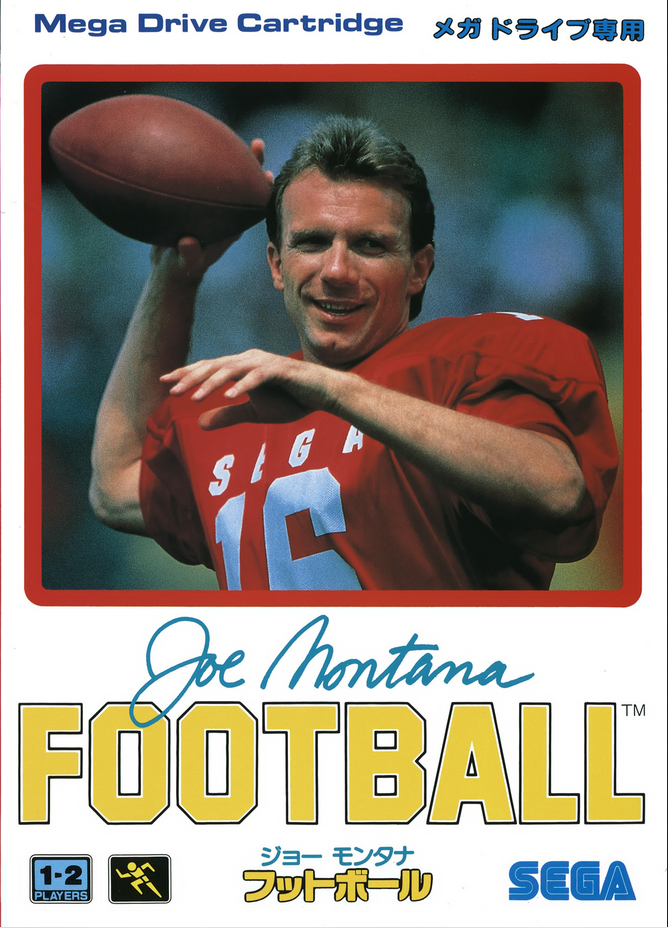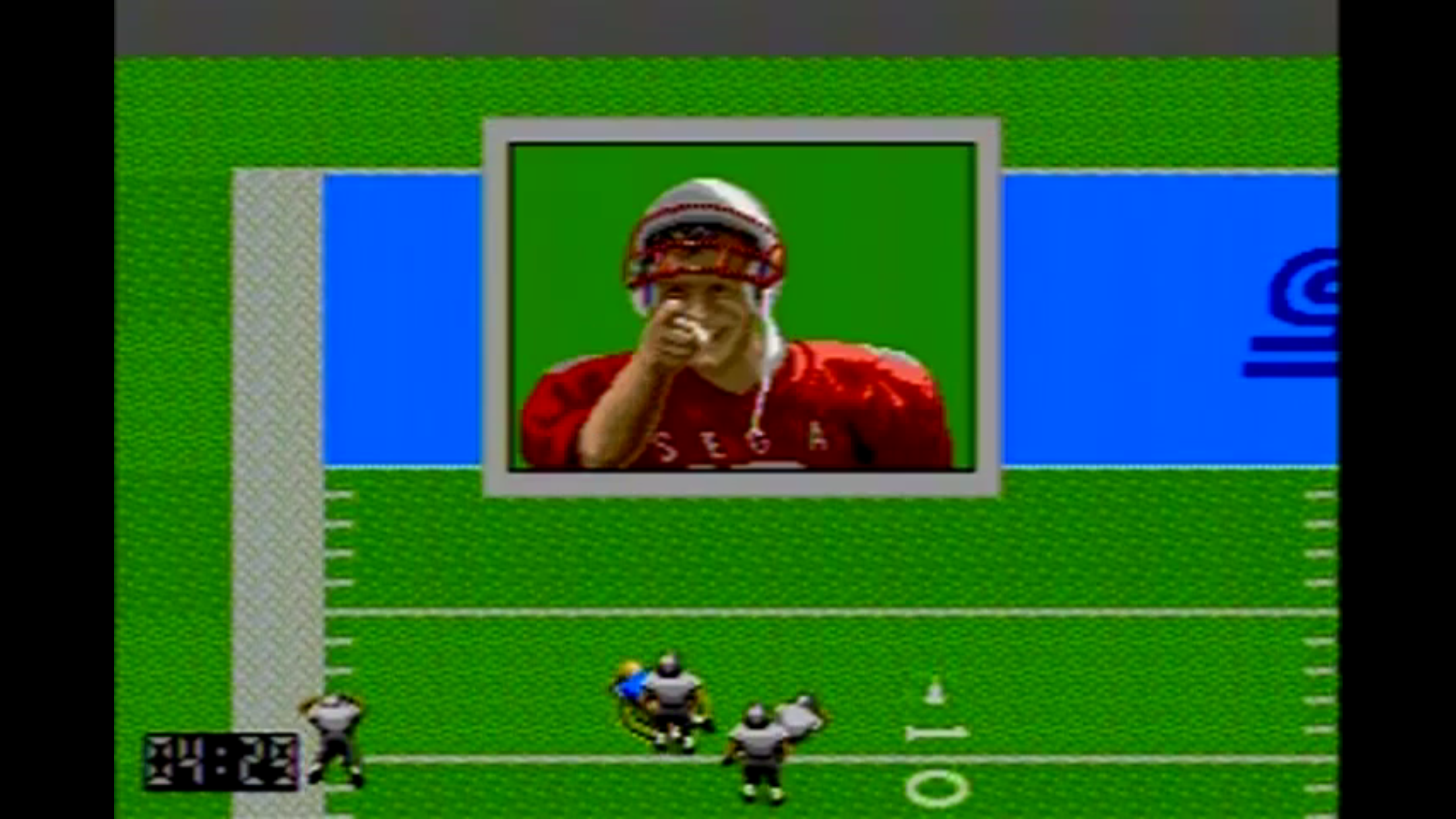This review is brought to you by the one and only Retro Referee, Peter Skerritt. Be sure to check out his work on Twitter @PeteSkerritt.


PLAYERS: 1-2 simultaneous
PUBLISHER: Sega
DEVELOPER: Park Place Productions
GENRE: Sports
RELEASE DATE: 12/22/90 – (US), 03/01/91 – (JP), 05/91 – (EU)
It’s the last play of the game. San Francisco remains ahead of Buffalo by two points, but Buffalo has just driven into field goal territory after completing a couple of deep passes. The kick is basically a chip shot, and converting it would complete a comeback from as many as 14 points down earlier in the game. Here’s the snap, the ball is down… and a San Francisco linebacker busts through the line! The kick is blocked! San Francisco hangs on to win the SEGA Bowl and Joe Montana hoists the championship trophy! What a game!

This isn’t a back-of-the-box writeup for Joe Montana Football. It’s exactly what happened to me while playing the game for review. It was incredibly exciting to experience, and it’s not necessarily common for many sports games to have that kind of a dramatic ending. Blocked kicks, interceptions, fumbles, and tipped passes snatched out of the air for big gains are all part of the Joe Montana Football package for the Genesis, and make for a solid—if not exciting—game of 16-bit American football.

As with John Madden Football, Joe Montana Football is a bit bare on the modes of play offered. Exhibition and SEGA Bowl are the two significant options. Exhibition games are single games played against the CPU or a human opponent for bragging rights. The SEGA Bowl mode runs for four games against increasingly difficult opponents with the championship trophy on the line. It’s worth noting that this game doesn’t employ a password system for the SEGA Bowl mode and there isn’t a battery inside of the cartridge to save progress. This means that there’s no way to save progress through the playoff run, should players want to come back to finish later. There’s also a two-minute drill mode of play, for those looking for a quicker experience. The options in Joe Montana Football are fairly basic and limited. Game length can be changed, and penalties can be turned on or off. There are only 16 teams to choose from here, as opposed to the 28 teams that John Madden offers.

It doesn’t take long to realize that Joe Montana has an arcade game feel to it. Kicking the football only requires one button press. There are fewer (and more manageable) plays to pick from, and the play-calling system is quite simple. Penalties, aside from the rogue pass interference call or silly offside calls when defensive players are a bit too eager to jump off of the line, are rarely called. Purists may scoff at the frequency of big plays that occur during a game, but these plays help keep more casual and/or arcade game fans to remain engaged.

While it is possible to have some success with the running game in Joe Montana, the passing game is the star of the show on offense. After the quarterback receives the snap, a press of the A button brings up window that shows a “first-person view” from inside of the quarterback’s helmet. This view shows the intended receiver and any defenders covering him. It’s possible to lead the receiver to a passing point by aiming the passing reticle to his left or right. Pressing A once more launches the pass toward the intended receiver, and the screen shifts to that point. The player then takes manual control of the receiver, who must be guided to where the pass is going. If the catch is made, the receiver is oftentimes able to streak up the field for a bunch of yards after the catch (or YAC). Errantly-thrown passes or moving the receiver to the wrong spot can lead to costly interceptions, so there’s a definite risk/reward element to the passing game—just like real football.

On the defensive side of the ball, playing well against the pass is often the key to victory. Covering opposing receivers effectively can lead to sacks, incompletions, and interceptions. Selecting plays in the Nickel and Dime formations usually work best in defending the pass, since extra defensive players are positioned in passing zones to cover opposing receivers. Relying on the blitz, or having defenders focus on chasing the quarterback, too often leads to big pass plays being given up. Making a play at an interception is as easy as positioning the defensive player underneath the ball… but don’t jostle too much with the receiver, or else a pass interference penalty may be called.

The play controls for Joe Montana are responsive and easy to learn. The play-calling screen could have been designed a bit differently, as it’s too easy to call the wrong play and be forced to call a time out in order to change it, but that’s more of a nitpick than a serious complaint. While there aren’t any difficulty settings to choose from, playing through the SEGA Bowl mode showcases a gradual rise of challenge from the first game through the Championship game. Playing against a friend is the best way to go, but the CPU can pose surprising resistance to defeat and test skilled players during the last two games of the mode.

Aesthetically, Joe Montana is decent, especially by early 16-bit era standards. On the field, the players are animated well, as they run, jump, and dive. The frame rate is smooth also, and the presentation is anchored by digitized images and a few animated cutscenes featuring the titular quarterback. The sound is surprisingly clear, featuring clear voice clips from Montana as well as grunts and groans that are seemingly pulled from live action. The music is also quite good, with guitars and drums that punctuate scoring drives.

Joe Montana Football remains an enjoyable game more than 25 years after its release, in spite of missing some of the bells and whistles that other football games offer. The game’s arcade-style approach makes it accessible for players of all skill levels, and big plays in the passing game and on defense keep things exciting. It’s also hard to deny that having Joe Montana point to you after a big passing play and say, “Great catch!” is pretty darned cool… as in “Joe Cool”.
B+


5 replies on “Joe Montana Football (Genesis, 1990)”
Dang, I may have to go back and try this one sometime. My friend had this before Madden. I remember it being fun, and playing pretty ‘smoothly’ compared to some other early football sims. Good stuff.
Interesting how nobody knew the great irony, that the Joe Montana and John Madden series would be fierce competitors in the video football wars, yet the first entries in both series were done by the same company, Park Place Productions. And kudos to them for making this game a stark contrast to Madden 1 by focusing on arcade-like gameplay instead of realism like the other game.
As good as Madden was, I played this game quite a bit. It has some strengths over Madden in some areas. But really both good playing games. I still like Madden better but I liked this one too because it played differently. So you could go back and forth between them and Cyberball without feeling like you were playing the same game.
It’s a decent game, but Madden was more realistic which is what I was looking for back then. Also it wouldn’t be a Sega sports game without the obligatory Sega ad in the end zone or stadium.
Wouldn’t want to forget that you’re playing a Sega game on your Sega Genesis.